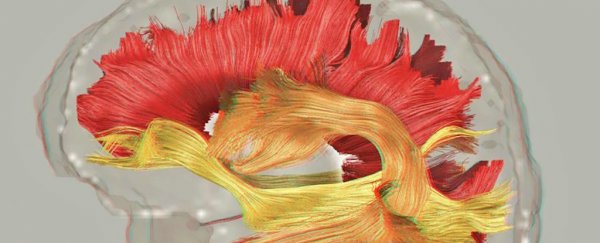Schizophrenia can disrupt the entire communication system running through the brain, a new study has found, affecting more regions of the mind than scientists previously thought and shedding new light on how the condition takes hold.
It's the largest study so far of how white matter (the brain's fatty tissue that enables neurons to communicate) relates to a psychiatric disease, and could help us figure out the mechanisms behind schizophrenia and other mental illnesses.
According to the international team of researchers, if we know more about where to look in the brain for the causes and effects of schizophrenia, then we can find more effective treatments – and this study answers that question of where schizophrenia takes root pretty comprehensively.
"We can definitively say for the first time that schizophrenia is a disorder where white matter wiring is frayed throughout the brain," says one of the team, Sinead Kelly, who was at the University of Southern California (USC) when the study was conducted, and is now at the Harvard Medical School.
The World Health Organisation says 21 million people are affected by schizophrenia worldwide, and up until now it was thought that most of the damage done by the condition was in the prefrontal and temporal lobes.
Those are the parts of the brain responsible for hearing, defining our personality, and making decisions.
But the new study says communications are disrupted all over the brain, like frayed telephone or internet cables – particularly in the corpus callosum, which controls communication between the two hemispheres of the brain.
Another badly affected area was the front part of the corona radiata, one of the brain's key structures for processing information.
The researchers pulled together a vast set of data, covering 1,963 people with the disorder and 2,359 healthy controls from 29 different international studies.
Data taken via a form of MRI called diffusion tensor imaging was used, which measures how water molecules move in white matter, and shows where the brain's communication network isn't as well insulated as it should be.
It's a pretty bleak picture in terms of the brain damage associated with schizophrenia, but the more we know, the better we can treat the problem.
"Our study will help improve the understanding of the mechanisms behind schizophrenia, a mental illness that – left untreated – often leads to unemployment, homelessness, substance abuse and even suicide," says Kelly.
"These findings could lead to the identification of biomarkers that enable researchers to test patients' response to schizophrenia treatment."
While we know a lot about the symptoms and consequences of schizophrenia, not much is understood about how it's caused or gets started. Those with the disorder can experience hallucinations and delusions, as well as having trouble thinking and concentrating.
Though the condition can be managed with drugs, those drugs can have some pretty severe side effects, and we're yet to find any way to cure people completely.
Part of the work researchers will be doing in the future is examining exactly how these communication networks in white matter get damaged in the first place – and now they know to look for genes affecting the brain's entire infrastructure, rather than one particular section of internal cabling.
"Without this study, future research could have been misdirected," says one of the researchers, Neda Jahanshad from USC.
"We're showing that just studying a single brain region to try to find out what causes schizophrenia is not a good approach. The effect is global. Focusing on a certain part of the brain where you think that effect will be is not going to give you the whole story."
The research has been published in Molecular Psychiatry.
